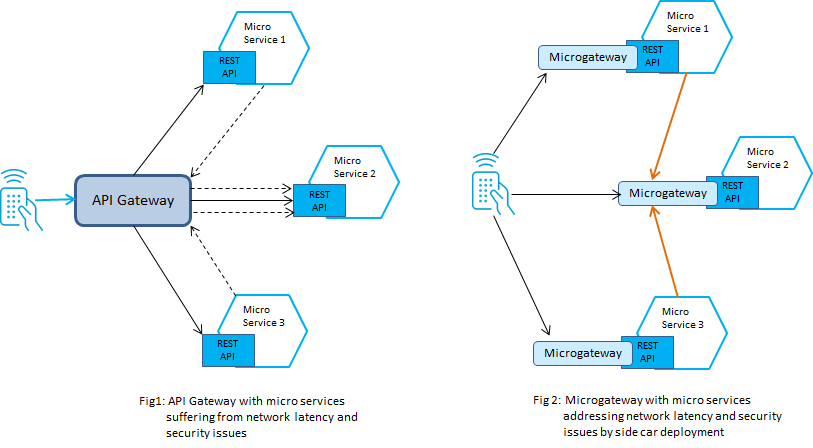Introduction
The adoption of the micro-service architecture pattern drives the need for lightweight gateways or Microgateways. The Microgateway gives control over a micro-service landscape by enforcing policies which perform authentication, traffic monitoring, and traffic management. The lightweight nature of a Microgateway allows a flexible deployment to avoid gaps or bottlenecks in the policy enforcement.
Microgateway is a gateway that enables micro-services to communicate with each other directly without re-routing the communication channel through an API Gateway. This eases out the traffic overload on API Gateway with communication between micro-services. You can enforce the required protection policies on the Microgateway to have a secure communication channel between the micro-services.
This figure illustrates an API Gateway with micro-services suffering from network latency and security issues as figure 1 followed by figure 2 that depicts a Microgateway with micro-services addressing network latency and security issues by side car deployment.
The first part, figure 1, of the diagram depicts micro-services with a single API Gateway that does the enforcement of policies. Here, each micro-service exposes an endpoint where no policy enforcement is done. Moreover, considering that the micro-services are interacting with each other, all the traffic needs to be routed to the API Gateway. This leads to additional network latency and the API Gateway might become a bottleneck. In the second part, figure 2, API Gateway is replaced with a set of Microgateways that are deployed near the micro-services. Such a sidecar deployment does not leave any gaps and avoids bottlenecks, thereby solving the network latency issues and ease of policy enforcement.
Microgateway Components
Microgateway comes with a service performing the policy enforcement on REST APIs. The Microgateway service runs within its own Java runtime environment and is controlled by a simple command line interface that supports basic lifecycle operations like start and stop. The configuration of the service consists of system settings and assets that can be provisioned from a running API Gateway or can be provisioned through a filesystem. The provisioned assets include application, API, policy, and alias definitions. The Microgateway service exposes an administrator REST API to query the status, the system setting, and the provisioned assets and shut down Microgateway as well.

